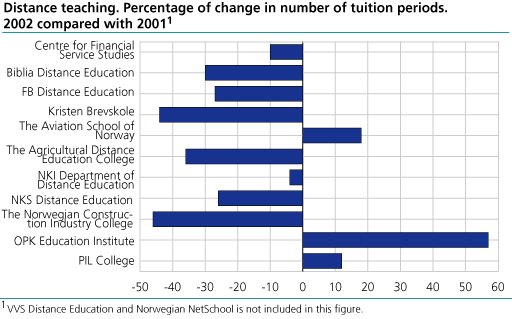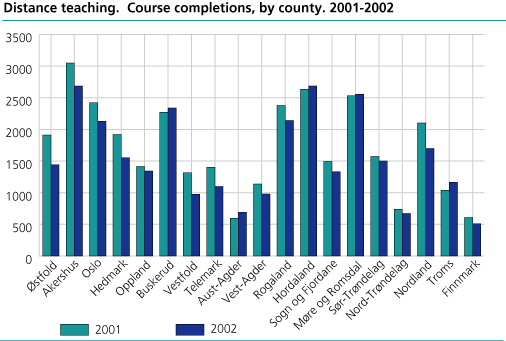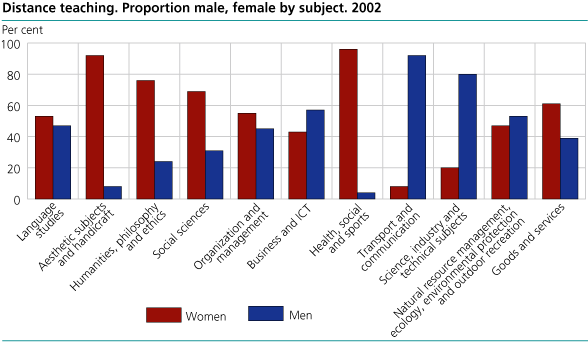Content
Published:
This is an archived release.
Fifth year of decrease in course activity
For the fifth year in a row, the course activity of the independent distance teaching institutions continued to decrease in 2002. Compared with the previous year, there were 3000 less course completions and 600 000 less tuition periods.
12 independent distance-teaching institutions reported a total of 29,749 course completions during 2002. The same institutions produced close to 4.5 million tuition periods.
150 tuition periods on average
On average each course participant had 150 tuition periods. The highest average number of tuition periods was found on courses arranged by NSM BI-Centre for Financial Service Studies with 295 tuition periods, while the lowest average was at The Aviation School of Norway with 68.
Three institutions accounted for 80 per cent of all course completions and tuition periods; NKI Department of Distance Education, NKS Distance Education and FB Distance Education. NKI topped the number of course completions and tuition periods. Compared with the previous year NKI had 2 per cent fewer course completions and 4 per cent less tuition periods during 2002.
The Norwegian Construction Industry College and Kristen Brevskole had the most marked decrease in course activity. Both institutions had about 45 per cent less course completions and tuition periods.
In spite of the reduced total course activity, two institutions had considerable increase in their course activity during 2002. OPK Education Institute had 45 per cent more course completions and 57 per cent more tuition periods compared with the previous year. The Aviation School of Norway had a 15 per cent increase in course completions and 18 per cent increase in tuition periods during 2002.
Most participants from Akershus and Hordaland
Like previous years, the courses arranged by the independent distance teaching institutions had participants from all counties in Norway. Akershus and Hordaland had the most course completions of all counties, 2,686 and 2,684 respectively.
Traditional choice of subject
Business and ICT, social sciences and transport and communication were the most popular subjects. These three different subjects had about 5,500 participants each. Natural resource management, ecology, environmental protection and outdoor recreation were the least popular subject with only 187 course completions.
There was no significant change in male and female choice of subject. In health, social and sports subjects women accounted for 96 per cent. In aesthetic subjects and handicraft, 92 per cent of all course completions were women. In contrast, 92 per cent of all course completions within transport and communication subjects were men, as were 80 per cent of all course completions within science, industry and technical subjects.
Lower share offered public examination
Of those who completed courses at the level of either upper secondary schools or university and college level, 66 per cent were given the option of a public examination. In 1998, the corresponding figure was 80 per cent. On the other hand, the proportion of those who were offered an internal examination increased by 8 per cent from 2001.
85 per cent of all course completions were specified with level of teaching. 59 per cent of those with a specified level were at the upper secondary level, while the rest were at university and college level.
Tables:
- Table 1 Tuition periods, by institution and level. 2002
- Table 2 Course completions, by independent distance teaching institution and sex. 2002
- Table 3 Course completions, by age, sex and subject. 2002
- Table 4 Course completions, by percentage females and age. 2002
- Table 5 Course completions, by age and sex. County. 2002
- Table 6 Tuition periods, by level. 1999-2002
- Table 7 Course completions, by type of education and age. 2002
- Table 8 Number of course completions, by examination and level. 1998-2002
This page has been discontinued, see .
Contact
-
Statistics Norway's Information Centre
E-mail: informasjon@ssb.no
tel.: (+47) 21 09 46 42



